Applying a Complex Integrated Method for Mapping and Assessment of the Degraded Ecosystem Hotspots from Romania
Abstract
:1. Introduction
2. Materials and Methods
2.1. Study Area
2.2. Data Used
2.3. Methods
3. Results and Discussions
4. Conclusions
Supplementary Materials
Author Contributions
Funding
Institutional Review Board Statement
Informed Consent Statement
Conflicts of Interest
References
- Chu, E.W.; Karr, J.R. Environmental impact: Concept, consequences, measurement. Ref. Modul. Life Sci. 2017. [Google Scholar] [CrossRef]
- Brumă, I.S. The evolution of organic agricultural land areas in the emerging countries of the European Union. Agric. Econ. Rural Dev. 2014, 11, 167–179. [Google Scholar]
- Malhi, Y.; Franklin, J.; Seddon, N.; Solan, M.; Turner, M.G.; Field, C.B.; Knowlton, N. Climate change and ecosystems: Threats, opportunities and solutions. Philos. Trans. R. Soc. B Biol. Sci. 2020, 375, 20190104. [Google Scholar] [CrossRef] [PubMed] [Green Version]
- Popescu, V.D.; Rozylowicz, L.; Niculae, I.M.; Cucu, A.L.; Hartel, T. Species, habitats, society: An evaluation of research supporting EU’s Natura 2000 network. PLoS ONE 2014, 9, e113648. [Google Scholar] [CrossRef] [PubMed] [Green Version]
- Rosca, S.-M.; Simonca, V.; Bilasco, S.; Vescan, I.; Fodorean, I.; Petrea, D.-P. The assessment of favourability and spatio-temporal dynamics of pinus mugo in the romanian carpathians using GIS technology and landsat images. Sustainability 2019, 11, 1–30. [Google Scholar] [CrossRef] [Green Version]
- Corpade, A.M.; Corpade, C.; Petrea, D.; Moldovan, C. Integrating environmental considerations into transportation planning through strategic environmental assessment. J. Settl. Spat. Plan. 2012, 3, 115–120. [Google Scholar]
- Plesnik, J.; Hosek, M.; Condé, S. A Concept of a Degraded Ecosystem in Theory and Practice—A Review; ETC/BD Report to the EEA; European Environment Agency: Paris, France, 2011; pp. 1–11. [Google Scholar]
- Ghazoul, J.; Burivalova, Z.; Garcia-Ulloa, J.; King, L.A. Conceptualizing forest degradation. Trends Ecol. Evol. 2015, 30, 622–632. [Google Scholar] [CrossRef] [PubMed]
- Maes, J.; Teller, A.; Erhard, M.; Grizzetti, B.; Barredo, J.I.; Paracchini, M.L.; Condé, S.; Somma, F.; Orgiazzi, A.; Jones, A.; et al. Mapping and Assessment of Ecosystems and their Services: An Analytical Framework for Ecosystem Condition; Publications Office of the European Union: Luxembourg, 2018; Available online: https://publications.europa.eu/en/publication-detail/-/publication/42d646b6-1c3a-11e8-ac73-01aa75ed71a1/language-en (accessed on 1 March 2021).
- Avram, S.; Croitoru, A.; Gheorghe, C.A.; Nicolae, M.; Badarau, S.A.; Barbos, I.M.; Radu, B.; Ciocanea, C.M.; Ciornei, L.; Corpade, A.M.; et al. Cartarea Ecosistemelor Naturale si Seminaturale Degradate; Romanian Academy Publishing House: Bucharest, Romania, 2018. [Google Scholar]
- Grădinaru, S.R.; Iojă, C.I.; Vânău, G.O.; Onose, D.A. Multi-dimensionality of land transformations: From definition to perspectives on land abandonment. Carpathian J. Earth Environ. Sci. 2020, 15, 167–177. [Google Scholar] [CrossRef]
- Senf, C.; Seidl, R. Mapping the forest disturbance regimes of Europe. Nat. Sustain. 2021, 4, 63–70. [Google Scholar] [CrossRef]
- Potapov, P.; Li, X.; Hernandez-Serna, A.; Tyukavina, A.; Hansen, M.C.; Kommareddy, A.; Pickens, A.; Turubanova, S.; Tang, H.; Silva, C.E.; et al. Mapping global forest canopy height through integration of GEDI and Landsat data. Remote Sens. Environ. 2021, 253, 112165. [Google Scholar] [CrossRef]
- Kumar, P.; Krishna, A.P.; Rasmussen, T.M.; Pal, M.K. Rapid Evaluation and validation method of above ground forest biomass estimation using optical remote sensing in tundi reserved forest area, India. ISPRS Int. J. Geo-Inf. 2021, 10, 29. [Google Scholar] [CrossRef]
- Williams, L.J.; Cavender-Bares, J.; Townsend, P.A.; Couture, J.J.; Wang, Z.; Stefanski, A.; Messier, C.; Reich, P.B. Remote spectral detection of biodiversity effects on forest biomass. Nat. Ecol. Evol. 2021, 5, 46–54. [Google Scholar] [CrossRef] [PubMed]
- Meng, B.; Liang, T.; Yi, S.; Yin, J.; Cui, X.; Ge, J.; Hou, M.; Lv, Y.; Sun, Y. Modeling alpine grassland above ground biomass based on remote sensing data and machine learning algorithm: A case study in east of the Tibetan Plateau, China. IEEE J. Sel. Top. Appl. Earth Obs. Remote. Sens. 2020, 13, 2986–2995. [Google Scholar] [CrossRef]
- Wu, J.; Liang, S. Assessing terrestrial ecosystem resilience using satellite leaf area index. Remote Sens. 2020, 12, 1–20. [Google Scholar] [CrossRef]
- Kang, W.; Wang, T.; Liu, S. The response of vegetation phenology and productivity to drought in semi-arid regions of northern China. Remote Sens. 2018, 10, 727. [Google Scholar] [CrossRef] [Green Version]
- Pastick, N.J.; Wylie, B.K.; Wu, Z. Spatiotemporal analysis of Landsat-8 and Sentinel-2 data to support monitoring of dryland ecosystems. Remote Sens. 2018, 10, 791. [Google Scholar] [CrossRef] [Green Version]
- Maurya, P.; Das, A.K.; Kumari, R. Managing the blue carbon ecosystem: A remote sensing and GIS approach. In Advances in Remote Sensing for Natural Resource Monitoring; Wiley Online Books: London, UK, 2021. [Google Scholar] [CrossRef]
- Woodgate, W.; Disney, M.; Armston, J.D.; Jones, S.D.; Suarez, L.; Hill, M.J.; Wilkes, P.; Soto-Berelov, M.; Haywood, A.; Mellor, A. An improved theoretical model of canopy gap probability for Leaf Area Index estimation in woody ecosystems. For. Ecol. Manag. 2015, 358, 303–320. [Google Scholar] [CrossRef]
- Li, Z.; Xu, D.; Guo, X. Remote sensing of ecosystem health: Opportunities, challenges, and future perspectives. Sensors 2014, 14, 21117–21139. [Google Scholar] [CrossRef] [Green Version]
- Weiskopf, S.R.; Rubenstein, M.A.; Crozier, L.G.; Gaichas, S.; Griffis, R.; Halofsky, J.E.; Hyde, K.J.W.; Morelli, T.L.; Morisette, J.T.; Muñoz, R.C.; et al. Climate change effects on biodiversity, ecosystems, ecosystem services, and natural resource management in the United States. Sci. Total Environ. 2020, 733, 137782. [Google Scholar] [CrossRef]
- Praticò, S.; Solano, F.; Di Fazio, S.; Modica, G. Machine learning classification of mediterranean forest habitats in google earth engine based on seasonal sentinel-2 time-series and input image composition optimisation. Remote Sens. 2021, 13, 586. [Google Scholar] [CrossRef]
- Yousefi, S.; Pourghasemi, H.R.; Avand, M.; Janizadeh, S.; Tavangar, S.; Santosh, M. Assessment of land degradation using machine-learning techniques: A case of declining rangelands. Land Degrad. Develop. 2021, 32, 1452–1466. [Google Scholar] [CrossRef]
- Papp, L.; van Leeuwen, B.; Szilassi, P.; Tobak, Z.; Szatmári, J.; Árvai, M.; Mészáros, J.; Pásztor, L. Monitoring invasive plant species using hyperspectral remote sensing data. Land 2021, 10, 29. [Google Scholar] [CrossRef]
- Roman, A.; Gafta, D. Proximity to successionally advanced vegetation patches can make all the difference to plant community assembly. Plant Ecol. Divers. 2013, 6, 269–278. [Google Scholar] [CrossRef]
- Palaiologou, P.; Essen, M.; Hogland, J.; Kalabokidis, K. Locating forest management units using remote sensing and geostatistical tools in north-central Washington, USA. Sensors 2020, 20, 2454. [Google Scholar] [CrossRef] [PubMed]
- Maes, J.; Teller, A.; Erhard, M.; Condé, S.; Vallecillo, S.; Barredo, J.I.; Paracchini, M.L.; Abdul Malak, D.; Trombetti, M.; Vigiak, O. et al. Mapping and Assessment of Ecosystems and their Services: An EU Ecosystem Assessment; JRC Science for Policy Report; Publications Office of the European Union: Ispra, Italy, 2020; p. 452. [CrossRef]
- European Commission. Directorate-General for the Environment. Mapping and Assessment of Ecosystems and their Services Mapping and Assessing the Condition of Europe’s Ecosystems: Progress and Challenges: 3rd Report—Final. 20 March 2016. Available online: https://doi.org/10.2779/351581 (accessed on 8 February 2021). [CrossRef]
- EC. Communication from the Commission to the European Parliament, the Council, the European Economic and Social Committee and the Committee of the Regions, EU Biodiversity Strategy for 2030; European Commission: Brussels, Belgium, 2020. [Google Scholar]
- Kottek, M.; Grieser, J.; Beck, C.; Rudolf, B.; Rubel, F. World map of the Köppen-Geiger climate classification updated. Meteorol. Z. 2006, 15, 259–263. [Google Scholar] [CrossRef]
- EEA. Biogeographical Regions [WWW Document]. 2016. Available online: https://www.eea.europa.eu/data-and-maps/data/biogeographical-regions-europe-3 (accessed on 10 February 2021).
- Winkler, M.; Lamprecht, A.; Steinbauer, K.; Hülber, K.; Theurillat, J.-P.; Breiner, F.; Choler, P.; Ertl, S.; Gutiérrez Girón, A.; Rossi, G.; et al. The rich sides of mountain summits—A pan-European view on aspect preferences of alpine plants. J. Biogeogr. 2016, 43, 2261–2273. [Google Scholar] [CrossRef]
- APIA. LPIS [WWW Document]. 2017. Available online: https://lpis.apia.org.ro (accessed on 14 January 2021).
- DiMiceli, C.; Carroll, M.; Sohlberg, R.; Kim, D.; Kelly, M.; Townshend, J. MOD44B MODIS/Terra Vegetation Continuous Fields Yearly L3 Global 250 m SIN Grid [WWW Document]. 2015. ASA EOSDIS Land Processes DAAC. Available online: https://doi.org/https://doi.org/10.5067/MODIS/MOD44B.006 (accessed on 9 February 2021). [CrossRef]
- Hansen, M.C.; Potapov, P.V.; Moore, R.; Hancher, M.; Turubanova, S.A.; Tyukavina, A.; Thau, D.; Stehman, S.V.; Goetz, S.J.; Loveland, T.R.; et al. High-resolution global maps of 21st-century forest cover change. Science 2013, 342, 850–853. [Google Scholar] [CrossRef] [Green Version]
- APIA. LPIS [WWW Document]. 2013. Available online: https://lpis.apia.org.ro (accessed on 11 February 2021).
- ANCPI. Geoportal [WWW Document]. 2017. Available online: http://geoportal.ancpi.ro/geoportal (accessed on 15 February 2021).
- EEA. EU-DEM [WWW Document]. Copernicus Land Monitoring Service. 2016. Available online: https://land.copernicus.eu/imagery-in-situ/eu-dem/eu-dem-v1-0-and-derived-products/eu-dem-v1.0/view (accessed on 3 January 2021).
- INS. The General Agricultural Census [WWW Document]. 2017. Available online: https://insse.ro/cms (accessed on 18 February 2021).
- JRC. European Settlement Map [WWW Document]. 2016. Available online: https://land.copernicus.eu/pan-european/GHSL/european-settlement-map/EU GHSL 2014/view (accessed on 22 February 2021).
- ESA. Copernicus Open Access Hub [WWW Document]. 2017. Available online: https://scihub.copernicus.eu/dhus/#/home (accessed on 28 March 2021).
- Natura 2000 Sites [WWW Document]. 2017. Available online: http://www.mmediu.ro/articol/date-gis/434 (accessed on 20 December 2020).
- EEA. Corine Land Cover (CLC) 2012 [WWW Document]. 2016. Available online: http://land.copernicus.eu/pan-european/corine-land-cover/clc-2012/view (accessed on 16 December 2020).
- EEA. European Catchments and Rivers Network System (Ecrins) [WWW Document]. 2012. Available online: https://www.eea.europa.eu/data-and-maps/data/european-catchments-and-rivers-network (accessed on 14 November 2020).
- OSM. Open Street Map [WWW Document]. 2017. Available online: https://download.geofabrik.de (accessed on 4 April 2021).
- EEA. EU-Hydro—River Network Database [WWW Document]. 2017. Available online: https://land.copernicus.eu/imagery-in-situ/eu-hydro/eu-hydro-river-network-database (accessed on 11 December 2020).
- EEA. Riparian Zones 2012—Land Use Land Cover [WWW Document]. 2012. Available online: http://land.copernicus.eu/local/riparian-zones/land-cover-land-use-lclu-image/view (accessed on 9 November 2020).
- EEA. Waterbase—UWWTD: Urban Waste Water Treatment Directive [WWW Document]. 2015. Available online: https://www.eea.europa.eu/data-and-maps/data/waterbase-uwwtd-urban-waste-water-treatment-directive (accessed on 6 February 2021).
- INCPA. Romania Soils Map [WWW Document]. 2017. Available online: https://www.icpa.ro (accessed on 2 April 2021).
- INS. Number of Inhabitants [WWW Document]. 2017. Available online: https://insse.ro/cms (accessed on 7 November 2020).
- NASA USGS. EarthExplorer [WWW Document]. 2017. Available online: https://earthexplorer.usgs.gov (accessed on 17 November 2020).
- Niculae, M.I.; Avram, S.; Vanau, G.O.; Patroescu, M. Effectiveness of Natura 2000 network in Romanian Alpine Biogeographical Region: An assessment based on forest landscape connectivity. Ann. For. Res. 2014, 60, 19–32. [Google Scholar] [CrossRef] [Green Version]
- Roman, A.; Ursu, T.-M.; Onțel, I.; Marușca, T.; Grigore Pop, O.; Milanovici, S.; Sin-Schneider, A.; Adriana Gheorghe, C.; Avram, S.; Fărcaș, S.; et al. Deviation from grazing optimum in the grassland habitats of Romania within and outside the natura 2000 network. In Habitats of the World—Biodiversity and Threats; IntechOpen: London, UK, 2019. [Google Scholar] [CrossRef] [Green Version]
- Donato, C.R.; Ribeiro AD, S.; Souto, L.D.S. A conservation status index, as an auxiliary tool for the management of cave environments. Int. J. Speleol. 2014, 43, 315–322. [Google Scholar] [CrossRef] [Green Version]
- Avram, S.; Ciuinel, A.M.; Iu, C.; Manolache, A.M.; Negreanu, S.Ș.; Manta, N. Applying a new methodology for cave degradation assessment in Romania—Case study on Rodna Mountains National Park. Extrem. Life Biospeol. Astrobiol. 2017, 9, 22–31. [Google Scholar]
- Ciocănea, C.M.; Corpade, P.C.; Onose, D.A.; Vânău, G.O.; Maloş, C.; Petrovici, M.; Gheorghe, C.; Dedu, S.; Manta, N.; Szép, R.E. The assessment of lotic ecosystems de Fgradation using multi-Criteria analysis and gis techniques. Carpathian J. Earth Environ. Sci. 2019, 14, 255–268. [Google Scholar] [CrossRef]
- Romanelli, A.; Esquius, K.S.; Massone, H.E.; Escalante, A.H. GIS-based pollution hazard mapping and assessment framework of shallow lakes: Southeastern Pampean lakes (Argentina) as a case study. Environ. Monit. Assess. 2013, 185, 6943–6961. [Google Scholar] [CrossRef]
- Mirzaei, M.; Solgi, E.; Salman-Mahiny, A. Evaluation of surface water quality. Arch. Hyg. Sci. 2016, 5, 265–277. [Google Scholar]
- Niculae, M.I.; Avram, S.; Corpade, A.M.; Dedu, S.; Gheorghe, C.A.; Pascu, I.S.; Ontel, I.; Rodino, S. Evaluation of the quality of lentic ecosystems in Romania by a GIS based WRASTIC model. Scient. Rep. 2021, 11, 1–10. [Google Scholar] [CrossRef]
- Avram, S.; Cipu, C.; Corpade, A.-M.; Gheorghe, C.A.; Manta, N.; Niculae, M.-I.; Pascu, I.S.; Szép, R.E.; Rodino, S. GIS-Based multi-criteria analysis method for assessment of lake ecosystems degradation—Case study in Romania. Int. J. Environ. Res. Public Health 2021, 18, 5915. [Google Scholar] [CrossRef] [PubMed]
- Getis, A.; Ord, J.K. The analysis of spatial association by use of distance statistics. Geogr. Anal. 1992, 24, 189–206. [Google Scholar] [CrossRef]
- Ord, J.K.; Getis, A. Local spatial autocorrelation statistics: Distributional issues and an application. Geogr. Anal. 1995, 27, 286–306. [Google Scholar] [CrossRef]
- Sánchez-Martín, J.M.; Rengifo-Gallego, J.I.; Blas-Morato, R. Hot spot analysis versus cluster and outlier analysis: An enquiry into the grouping of rural accommodation in Extremadura (Spain). ISPRS Int. J. Geo-Inf. 2019, 8, 176. [Google Scholar] [CrossRef] [Green Version]
- ESRI. How Hot Spot Analysis (Getis-Ord Gi*) Works [WWW Document]. 2020. Available online: https://desktop.arcgis.com/en/arcmap/10.3/tools/spatial-statistics-toolbox/h-how-hot-spot-analysis-getis-ord-gi-spatial-stati.htm (accessed on 21 April 2021).
- Griffiths, P.; Kuemmerle, T.; Baumann, M.; Radeloff, V.C.; Abrudan, I.V.; Lieskovsky, J.; Hostert, P. Forest disturbances, forest recovery, and changes in forest types across the Carpathian ecoregion from 1985 to 2010 based on Landsat image composites. Remote Sens. Environ. 2014, 151, 72–88. [Google Scholar] [CrossRef]
- Drăgan, M.; Mureşan, G.-A.; Benedek, J. Mountain wood-pastures and forest cover loss in Romania. J. Land Use Sci. 2020, 14, 397–409. [Google Scholar] [CrossRef]
- Malek, Z.; Zumpano, V.; Haydar, H. Forest management and future changes to ecosystem services in the Romanian Carpathians. Environ. Dev. Sustain. 2018, 20, 1275–1291. [Google Scholar] [CrossRef] [Green Version]
- Moldovan, O.T.; Iepure, S.; Brad, T.; Kenesz, M.; Mirea, I.C.; Năstase-Bucur, R. Database of Romanian cave invertebrates with a Red List of cave species and a list of hotspot/coldspot caves. Biodivers. Data J. 2020, 8, e53571. [Google Scholar] [CrossRef] [PubMed]
- Constantin, S.; Mirea, I.C.; Petculescu, A.; Arghir, R.A.; Măntoiu, D.S.; Kenesz, M.; Robu, M.; Moldovan, O.T. Monitoring human impact in show caves. A study of four Romanian caves. Sustainability 2021, 13, 1619. [Google Scholar] [CrossRef]
- World Bank. Romania Water Diagnostic Report: Moving toward EU Compliance, Inclusion, and Water Security; World Bank: Washington, DC, USA, 2018. [Google Scholar]
- Sitar, C.; Barbu-Tudoran, L.; Moldovan, O.T. Morphological and micromorphological description of the larvae of two endemic species of duvalius (Coleoptera, Carabidae, Trechini). Biology 2021, 10, 627. [Google Scholar] [CrossRef] [PubMed]
- Moresi, F.V.; Maesano, M.; Collalti, A.; Sidle, R.C.; Matteucci, G.; Scarascia Mugnozza, G. Mapping landslide prediction through a GIS-based model: A case study in a catchment in southern Italy. Geosciences 2020, 10, 309. [Google Scholar] [CrossRef]
- Hysa, A.; Spalevic, V.; Dudic, B.; Roșca, S.; Kuriqi, A.; Bilașco, Ș.; Sestras, P. Utilizing the available open-source remotely sensed data in assessing the wildfire ignition and spread capacities of vegetated surfaces in Romania. Remote Sens. 2021, 13, 2737. [Google Scholar] [CrossRef]
- Shidong, Z. Concept of Ecosystem Services and Ecosystem Management; Springer: Berlin/Heidelberg, Germany, 2013. [Google Scholar] [CrossRef]
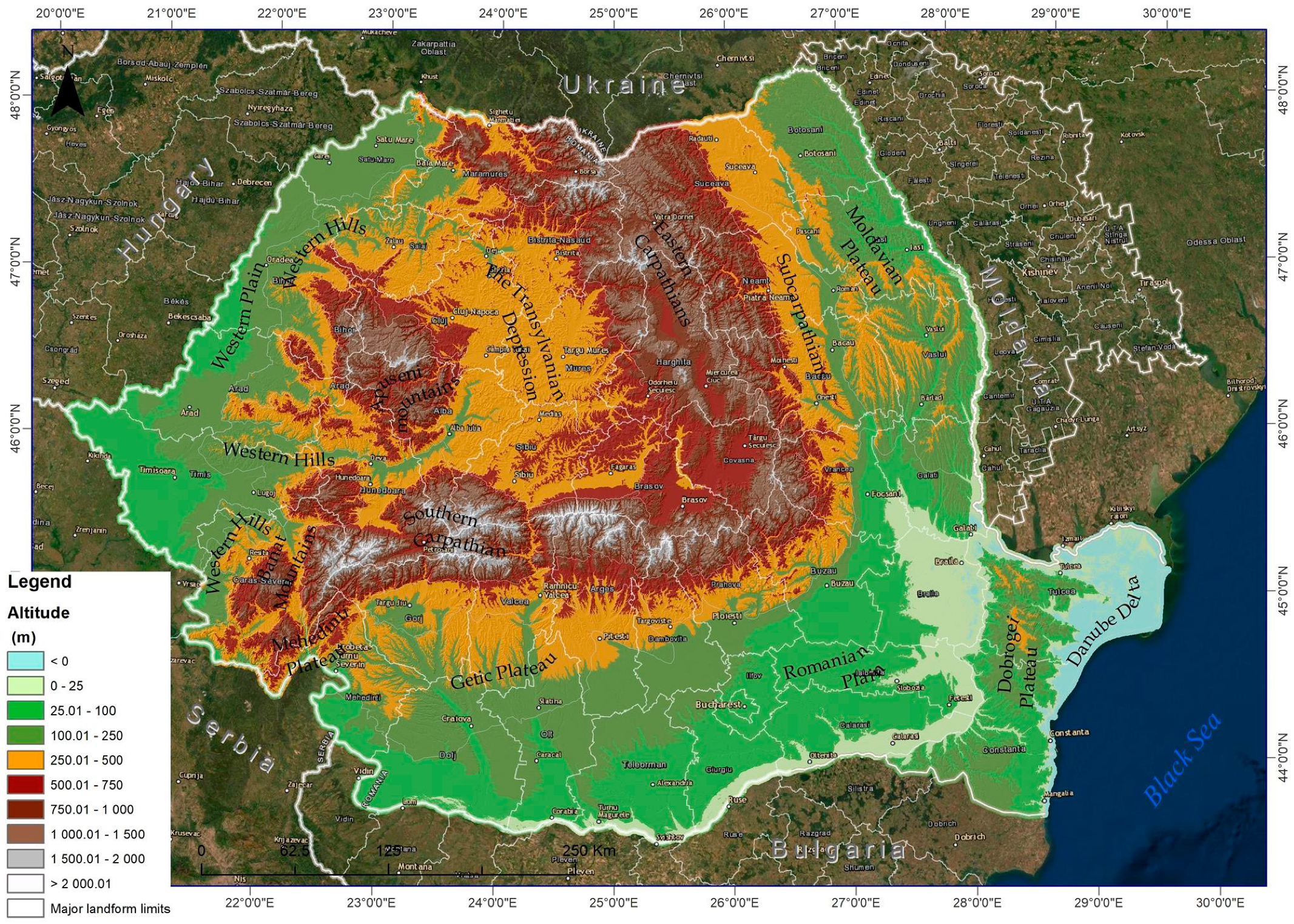
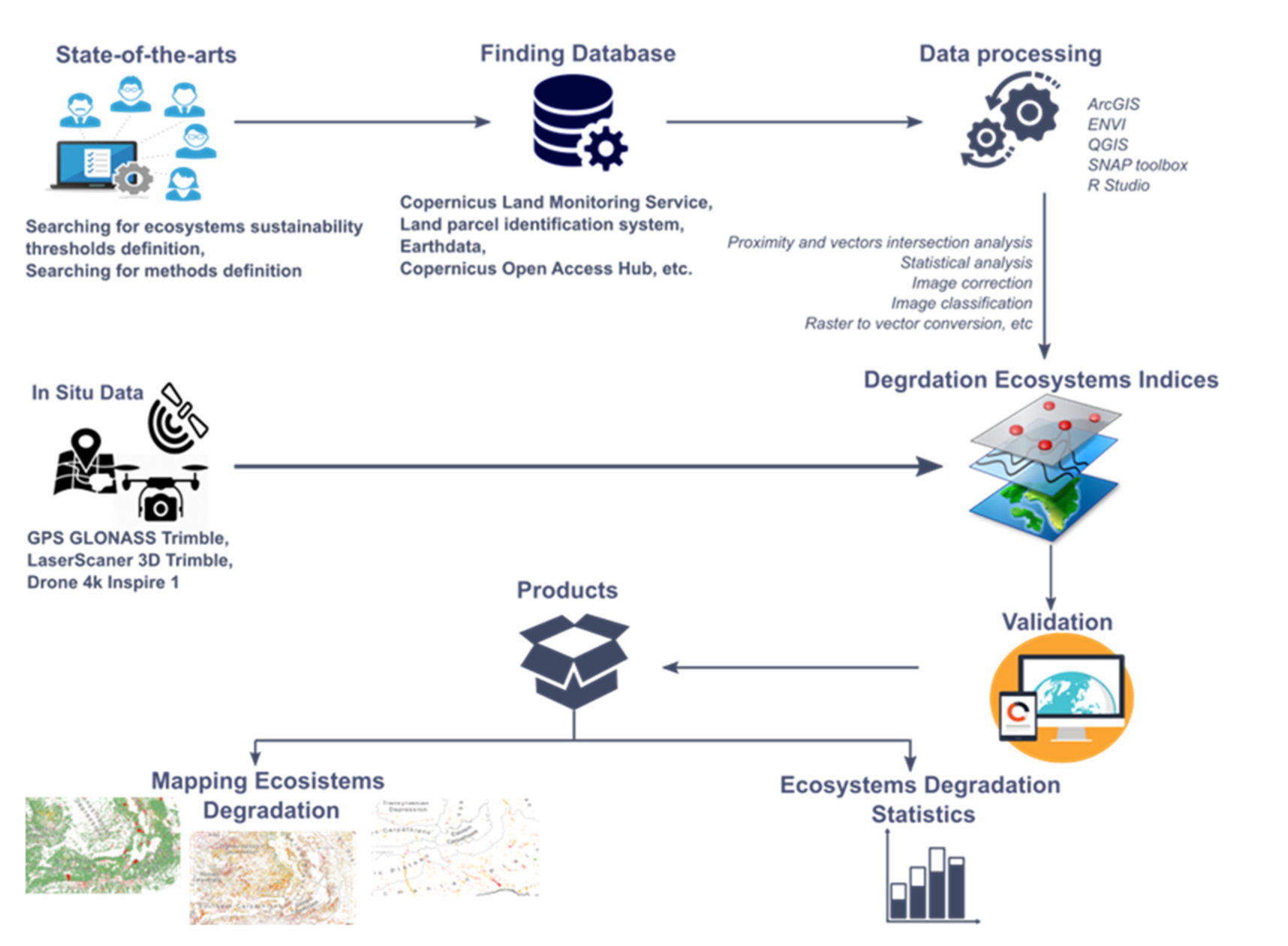
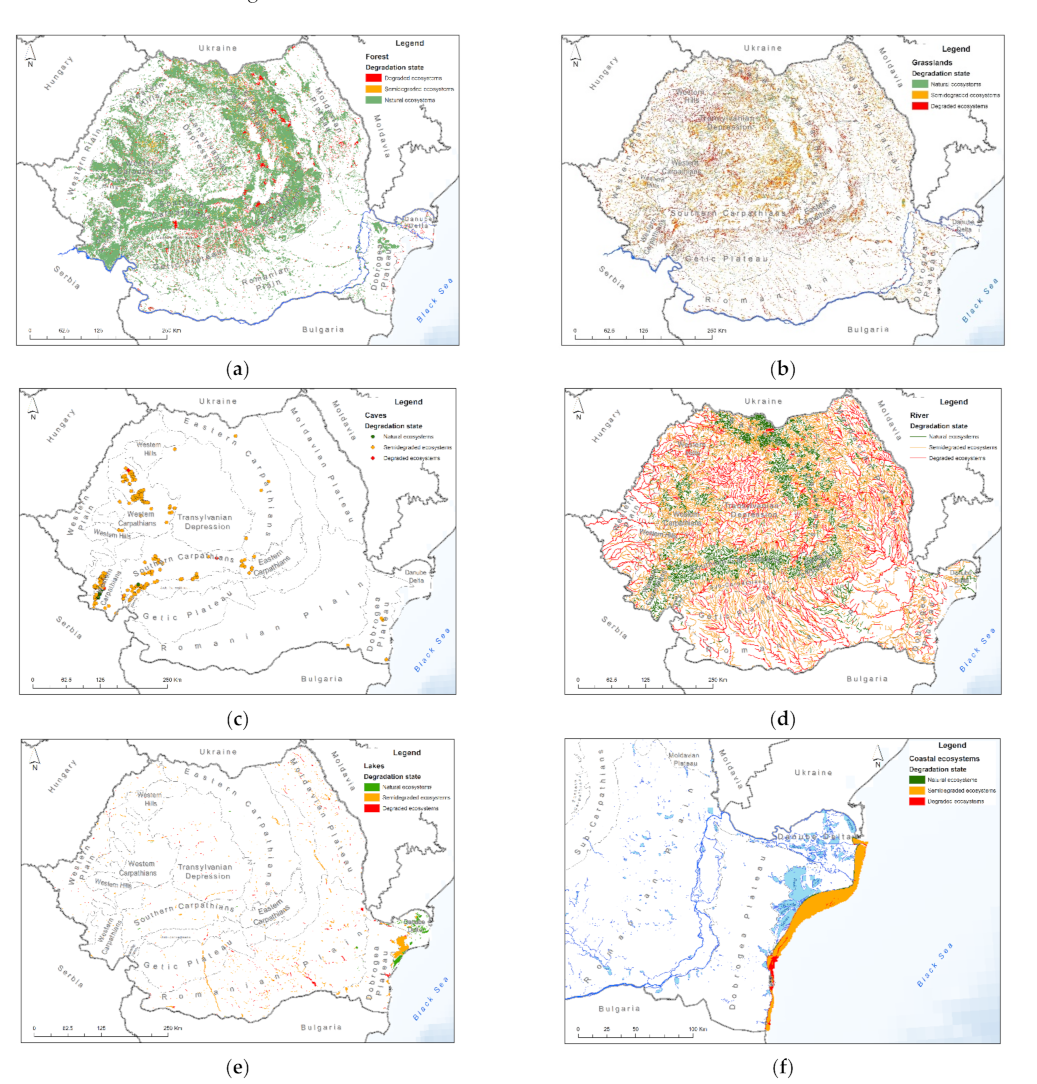
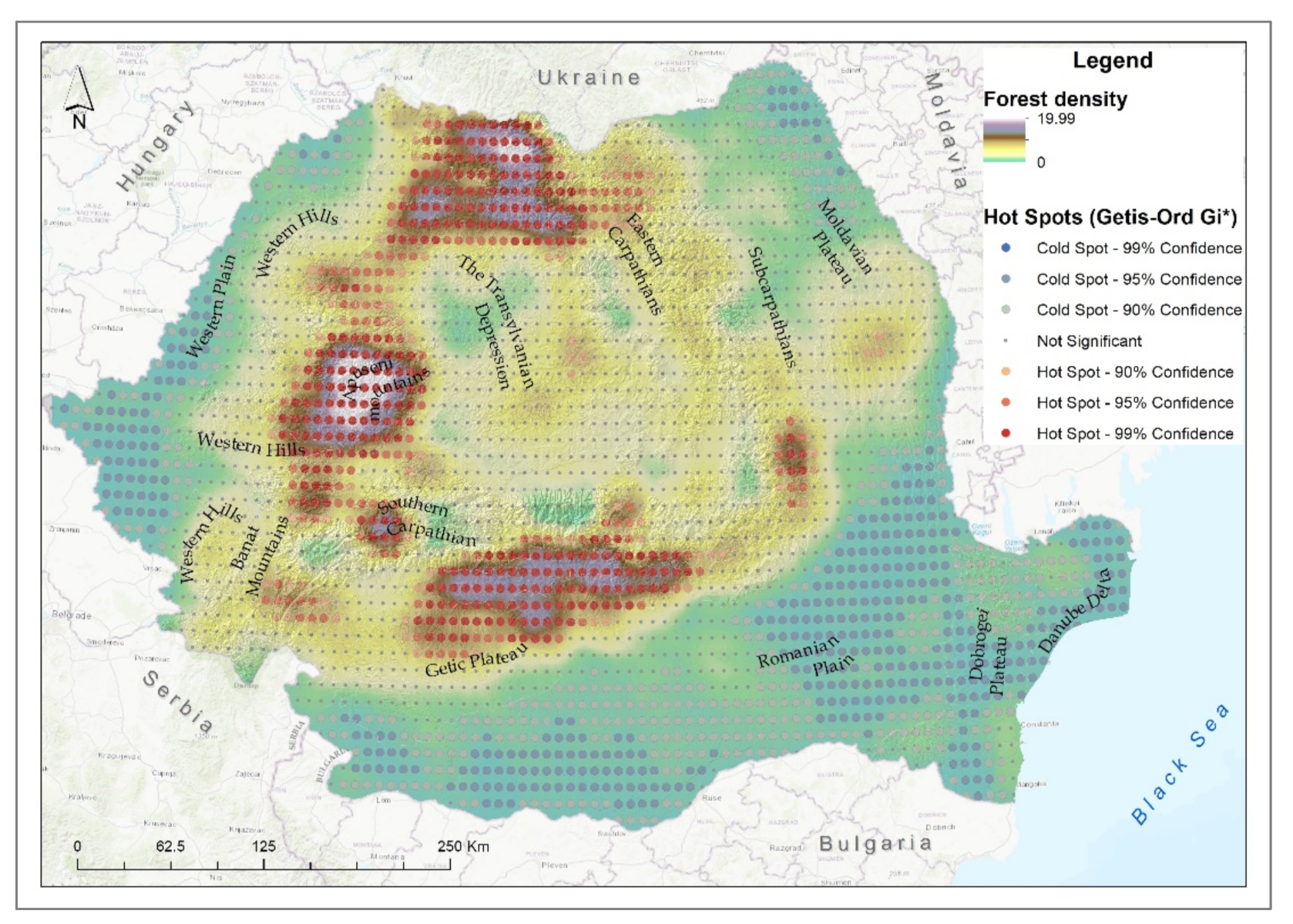
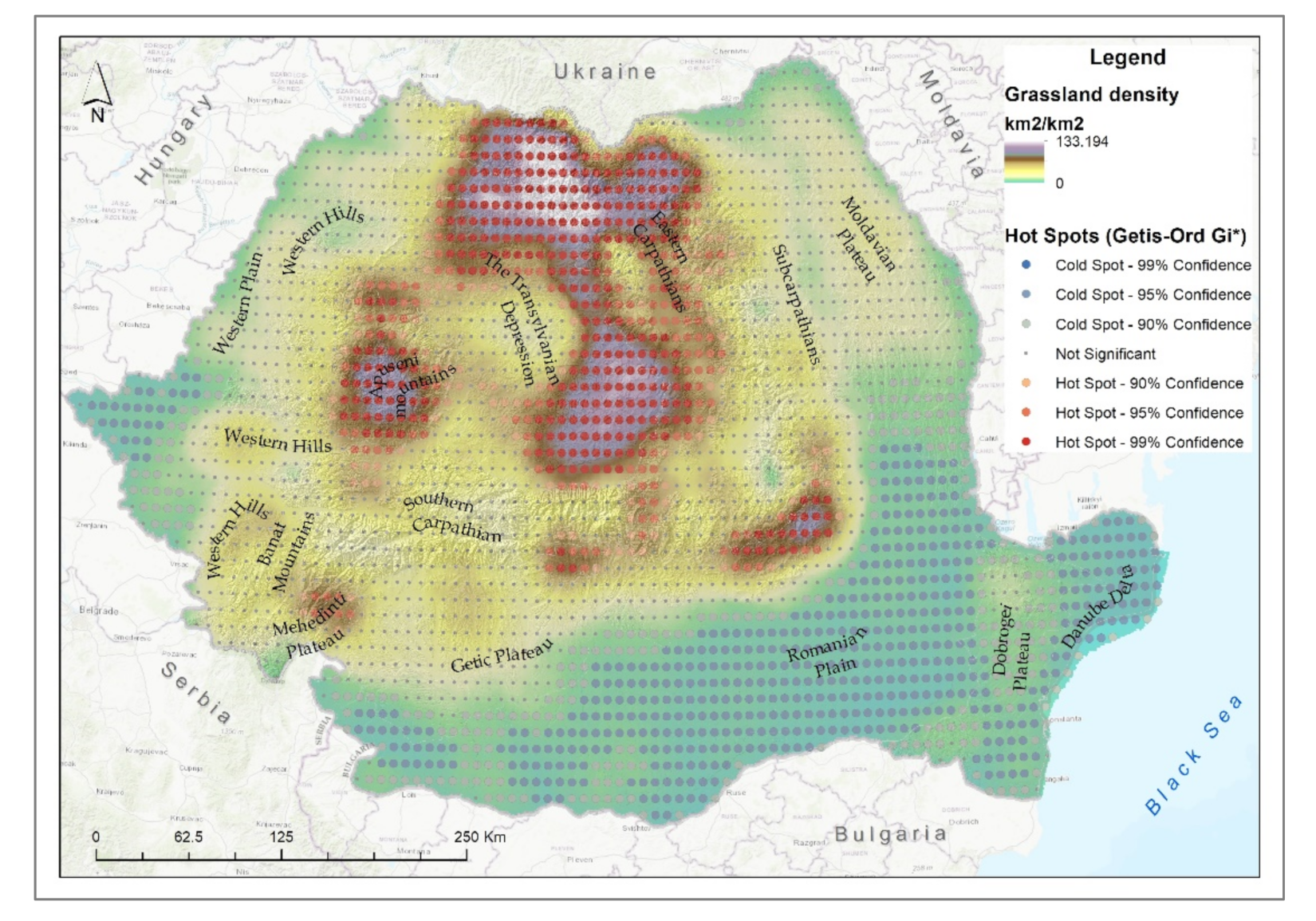
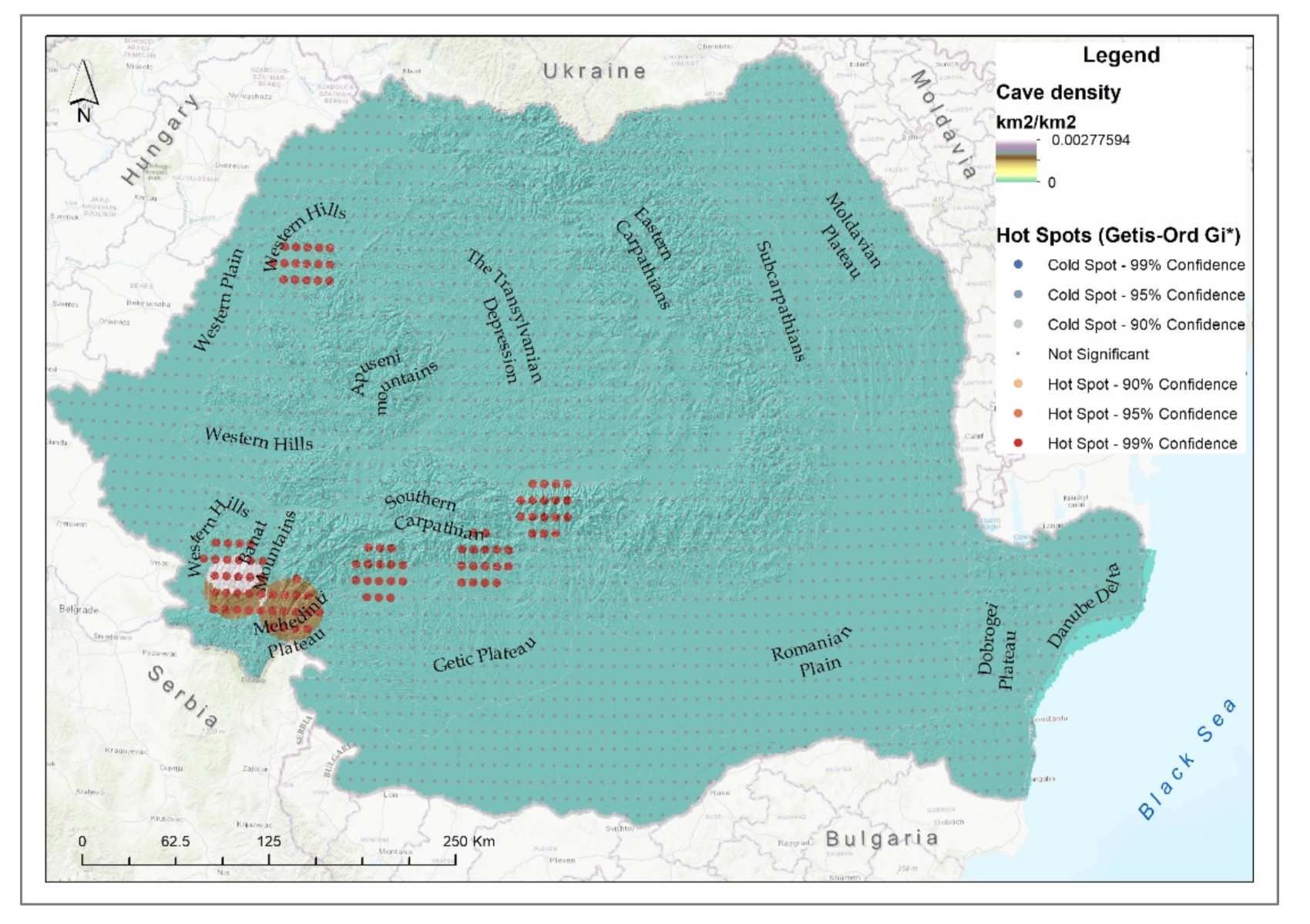
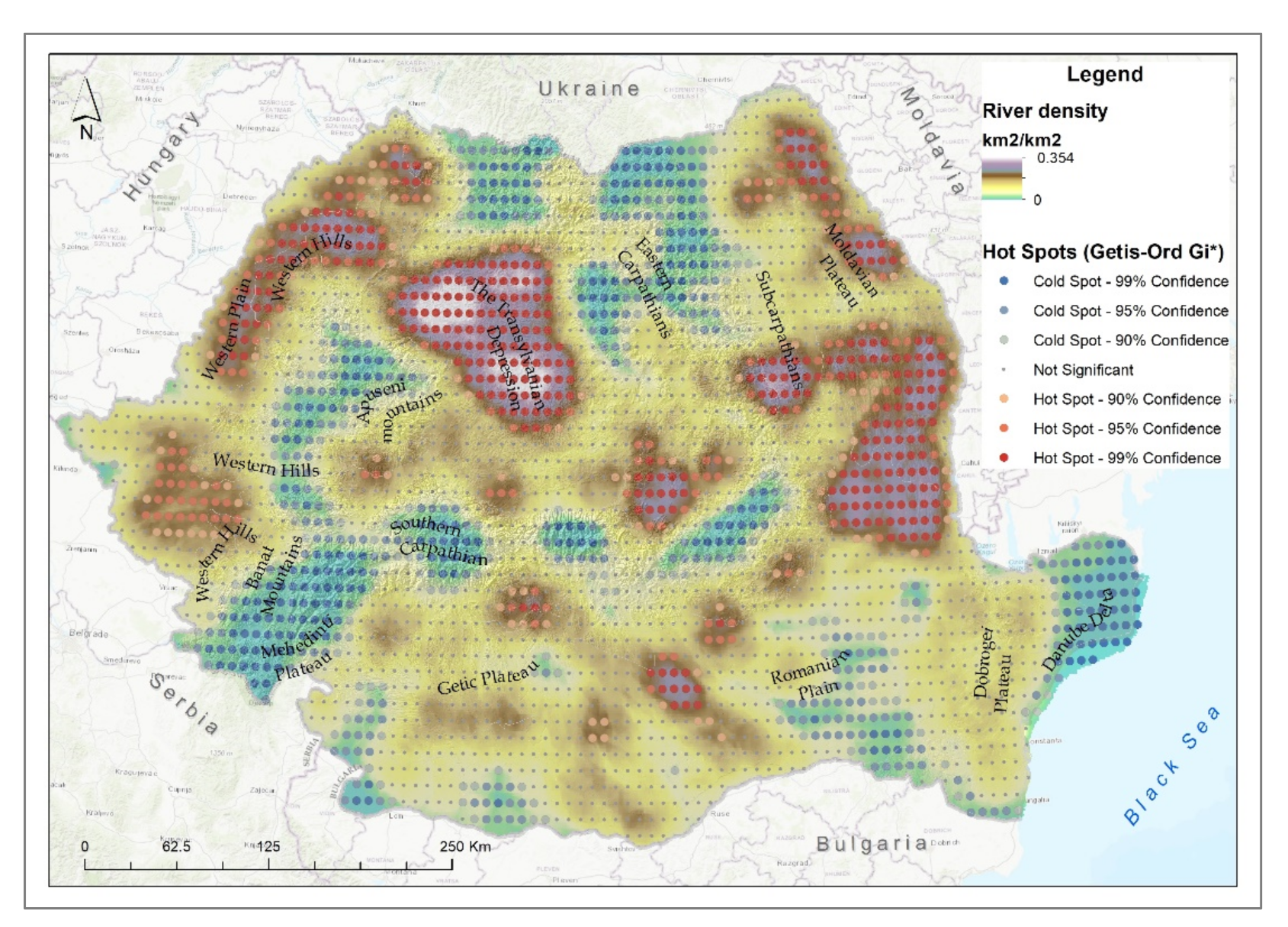
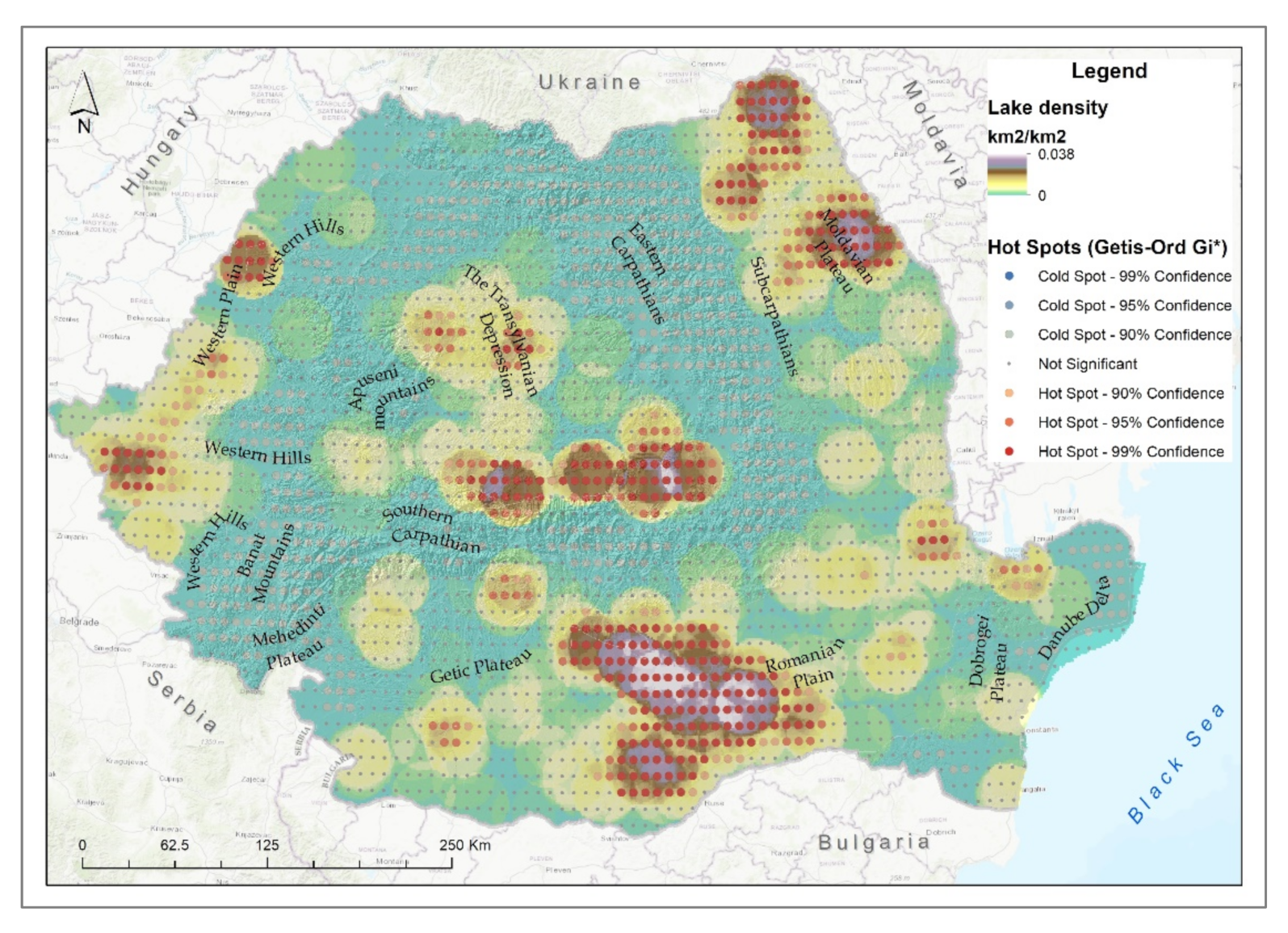
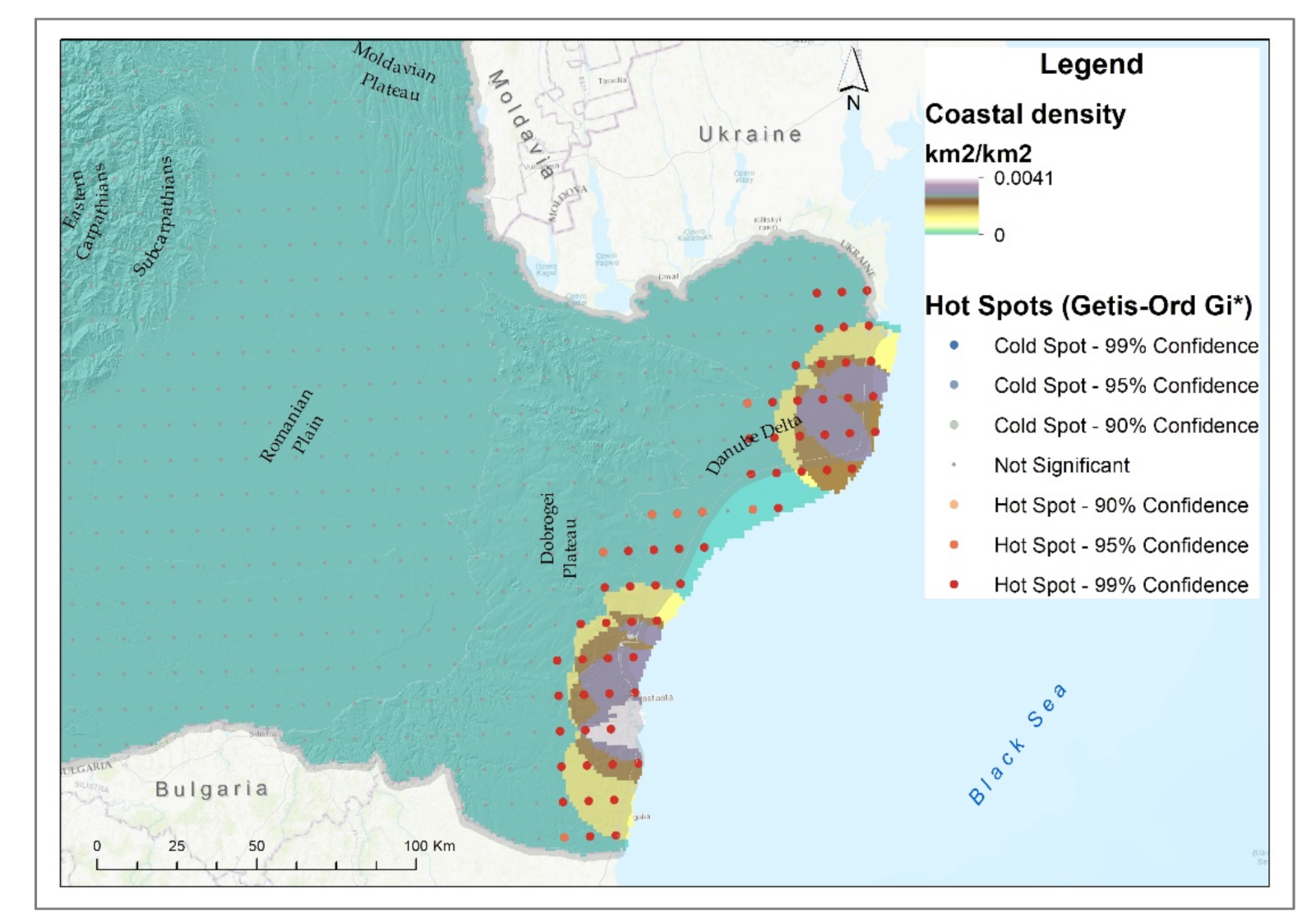
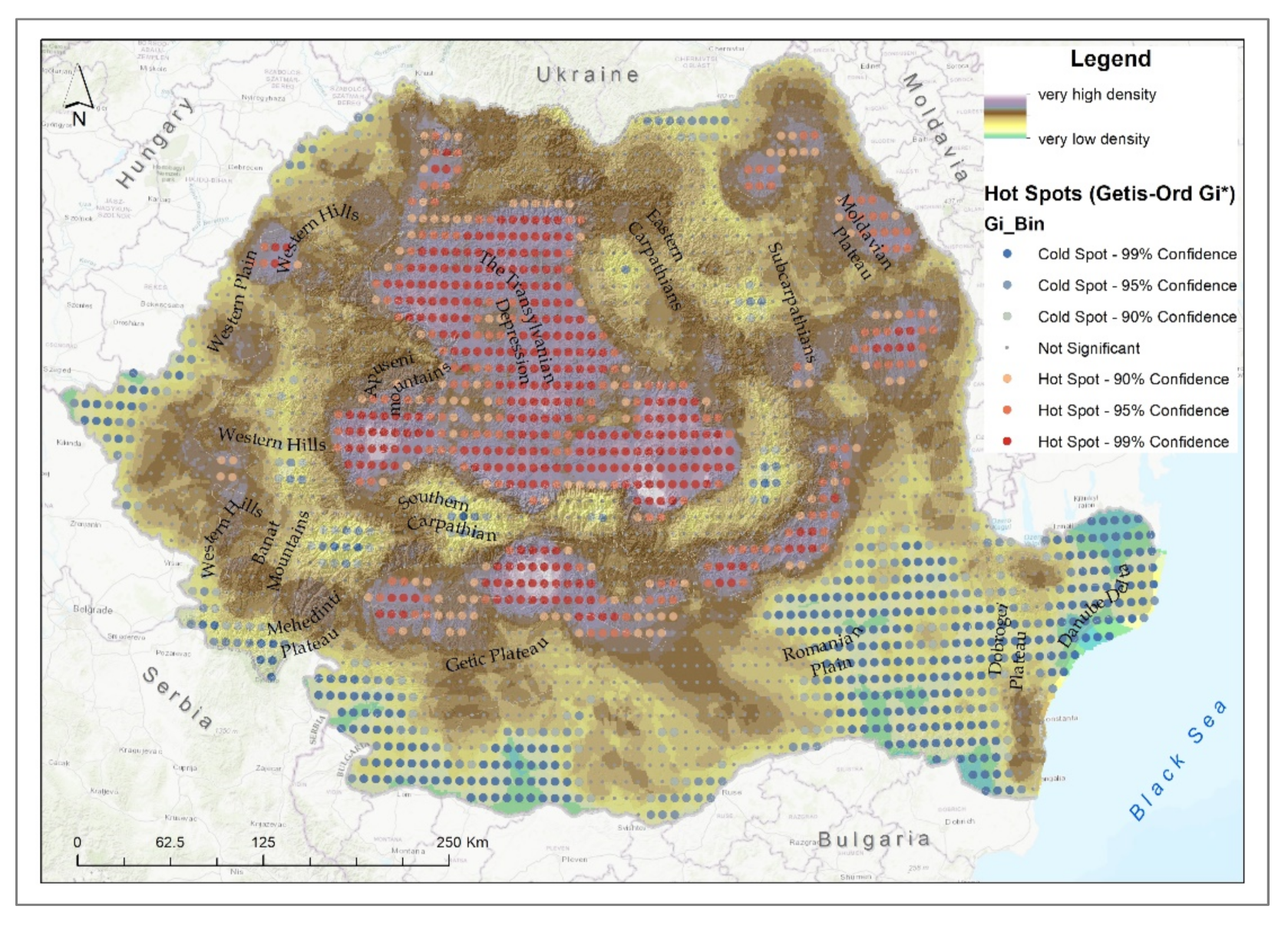
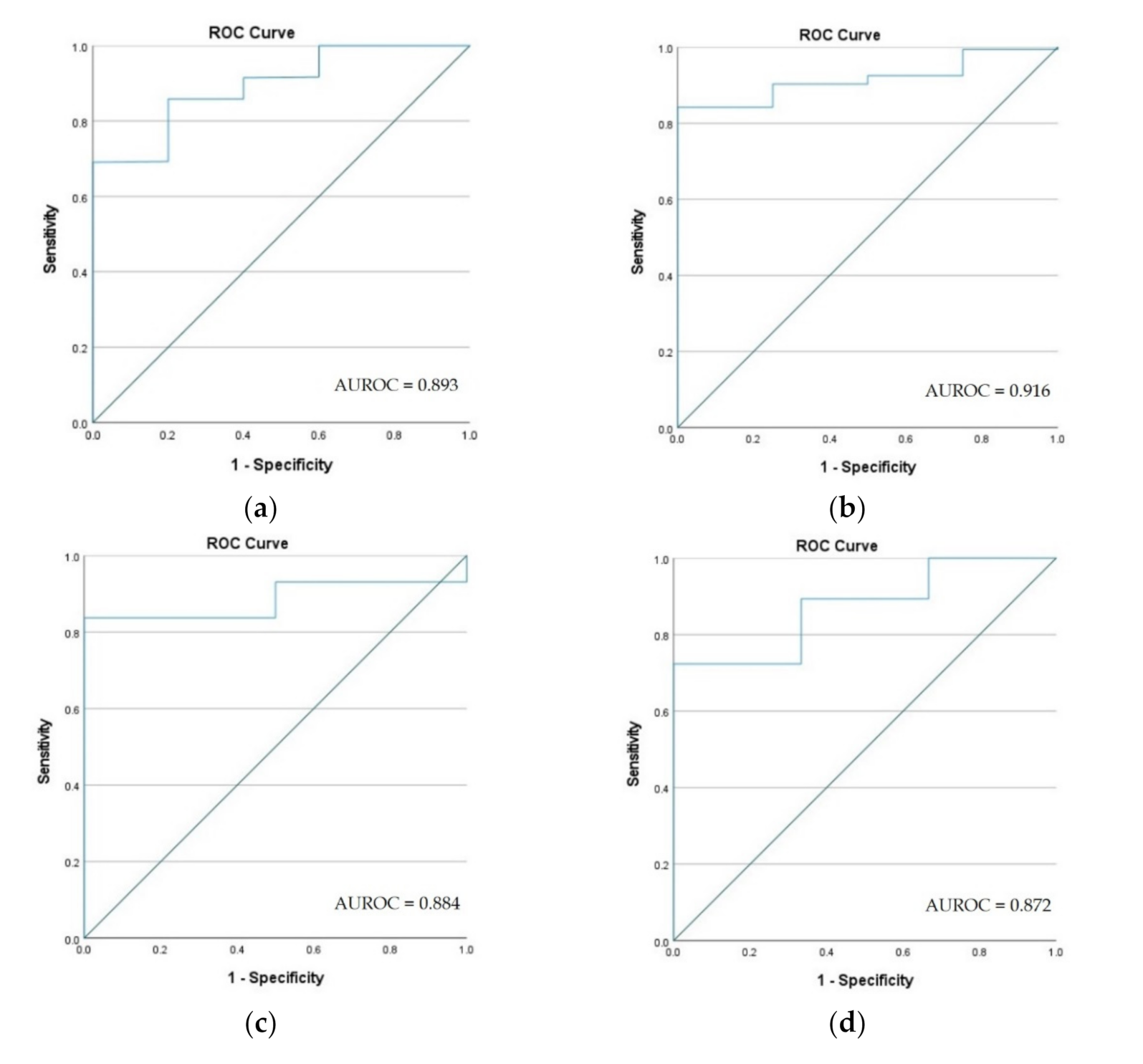
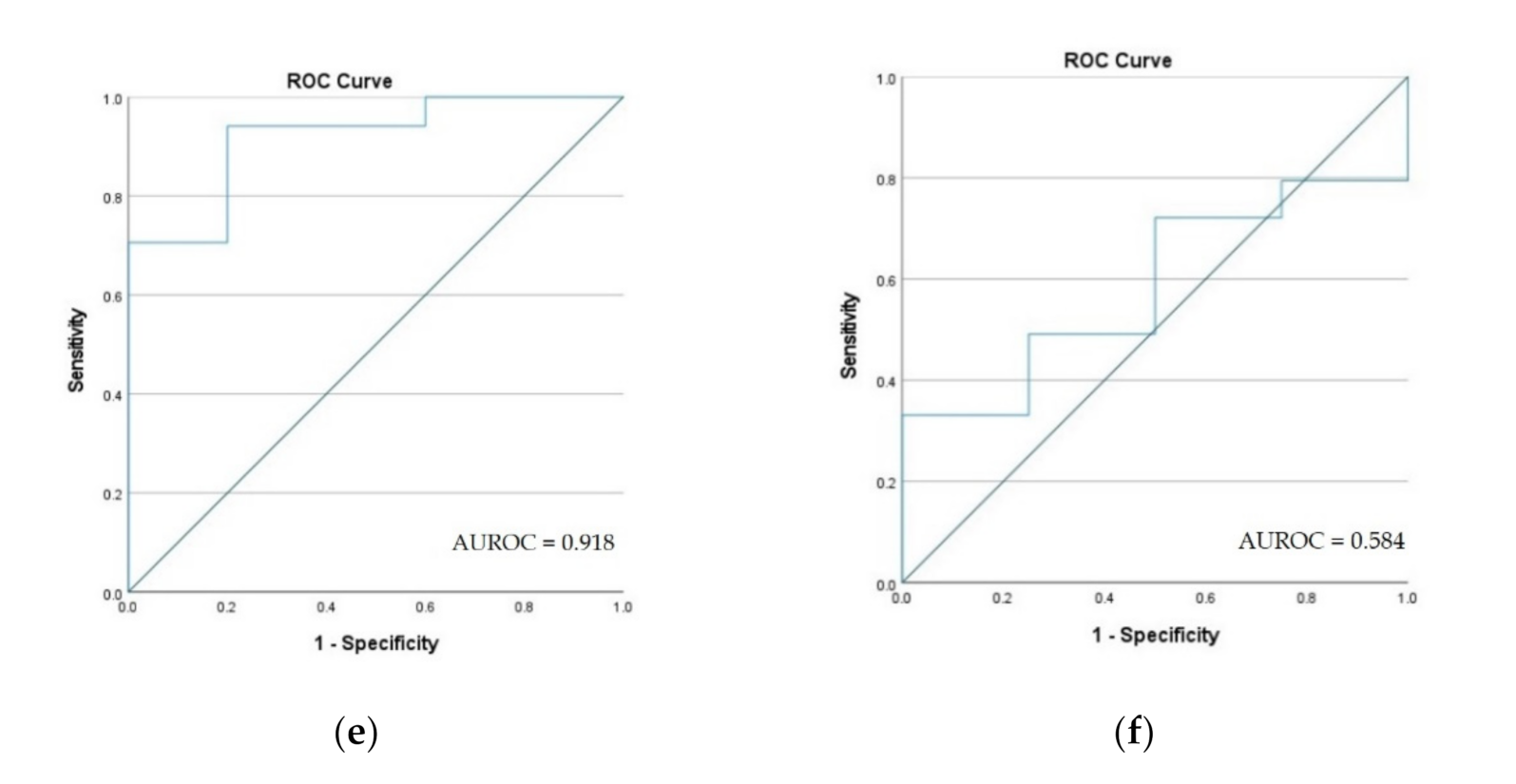
| Major Ecosystem Category | Ecosystem Type for Mapping and Assessment | Name of Datasets | Resolution/Minimum Mapping Unit | Time Reference | Source |
|---|---|---|---|---|---|
| Terrestrial | Forest | Land-parcel identification system (LPIS) | NA | 2013 | Land-parcel identification system from Romania [35] |
| Vegetation Continuous Fields (MOD44B) | 250 m | 2000–2013 | LAADS DAAC [36] | ||
| Hansen Global Forest Change | 30 m | 2000–2013 | Global Forest Change [37] | ||
| Grassland | Land-parcel identification system (LPIS) | NA | 2017 | Land-parcel identification system from Romania [38] | |
| Limits of territorial administrative units (TAUs) | NA | 2016 | National Agency for Cadastre and Land Registration of Romania [39] | ||
| Digital surface model (EU-DEM) | 25 m | 2011 | Copernicus Land Monitoring Service [40] | ||
| Livestock numbers and types from TAUs | NA | 2010 | National Statistics Institute of Romania [41] | ||
| European Settlement Map | 10 m | 2010–2013 | Copernicus Land Monitoring Service [42] | ||
| Sentinel 2 images | 10 m | 2015–2017 | Copernicus Open-Access Hub [43] | ||
| Cave | Natura 2000 (N2K) | NA | 2017 | Ministry of Environment, Waters and Forests [44] | |
| Orthophotos | 0.5 m | 2016 | National Agency for Cadastre and Land Registration of Romania [39] | ||
| CORINE Land Cover (CLC 2012) | 100 m | 2011–2012 | Copernicus Land Monitoring Service [45] | ||
| European Settlement Map | 10 m | 2010–2013 | Copernicus Land Monitoring Service [42] | ||
| European catchments and Rivers network system (ECRINS—dams on rivers) | 1:250,000 | 2012 | European Environment Agency [46] | ||
| Roads and railways | NA | 2016 | Open Street Map [47] | ||
| Fresh water | Rivers | EU-Hydro—River Network | 1 ha | 2006–2012 | Copernicus Land Monitoring Service [48] |
| European catchments and Rivers network system (ECRINS—dams on rivers) | 1:250,000 | 2012 | European Environment Agency [46] | ||
| Digital surface model (EU-DEM) | 25 m | 2011 | Copernicus Land Monitoring Service [49] | ||
| CORINE Land Cover (CLC 2012) | 100 m | 2011–2012 | Copernicus Land Monitoring Service [45] | ||
| European Settlement Map | 10 m | 2010–2013 | Copernicus Land Monitoring Service [42] | ||
| Riparian Zones 2012—Land Use Land Cover | 0.5 ha | 2011–2013 | Copernicus Land Monitoring Service [49] | ||
| Urban Wastewater Treatment (Water-based UWWTD) | NA | 2015 | European Environment Agency [50] | ||
| Natura 2000 (N2K) | NA | 2017 | Ministry of Environment, Waters and Forests [44] | ||
| Roads and railways | NA | 2016 | Open Street Map [47] | ||
| Romania soils map | NA | 2017 | National Institute of Research and Development for Pedology, Agro-chemistry and Environmental Protection [51] | ||
| Number of inhabitants from TAUs | NA | 2017 | National Statistics Institute of Romania [52] | ||
| Limits of territorial administrative units (TAUs) | NA | 2016 | National Agency for Cadastre and Land Registration of Romania [39] | ||
| Lakes | Permanent water bodies | 20 m | 2012 | Copernicus Land Monitoring Service | |
| CORINE Land Cover (CLC 2012) | 100 m | 2011–2012 | Copernicus Land Monitoring Service [45] | ||
| Digital surface model (EU-DEM) | 25 m | 2011 | Copernicus Land Monitoring Service [40] | ||
| Roads and railways | NA | 2016 | Open Street Map [47] | ||
| Exploitation areas of natural resources | NA | 2017 | National Agency for Mineral Resources | ||
| Natura 2000 (N2K) | NA | 2017 | Ministry of Environment, Waters and Forests [44] | ||
| Romania soils map | NA | 2017 | National Institute of Research and Development for Pedology, Agro-chemistry and Environmental Protection [51] | ||
| Urban Wastewater Treatment (Waterbased UWWTD) | NA | 2015 | European Environment Agency [50] | ||
| Limits of territorial administrative units (TAUs) | NA | 2016 | National Agency for Cadastre and Land Registration of Romania [39] | ||
| Landsat 8 | 30 m | 2016 | [53] | ||
| Marine | Coastal | CORINE Land Cover (CLC 2012) | 100 m | 2011–2012 | Copernicus Land Monitoring Service [45] |
| Digital surface model (EU-DEM) | 25 m | 2011 | Copernicus Land Monitoring Service [40] | ||
| Roads and railways | NA | 2016 | Open Street Map [47] | ||
| Urban Wastewater Treatment (Waterbased UWWTD) | NA | 2015 | European Environment Agency [50] | ||
| European Settlement Map | 10 m | 2010–2013 | Copernicus Land Monitoring Service [42] | ||
| Landsat 8 | 30 m | 2016 | [53] | ||
| Orthophotos | 0.5 m | 2016 | National Agency for Cadastre and Land Registration of Romania [39] |
| Ecosystem | Natural | % | Semi-Degraded | % | Degraded | % | Total |
|---|---|---|---|---|---|---|---|
| Forest (km2) | 63,651.34 | 88.54 | 2115.27 | 2.94 | 6124.23 | 8.52 | 71,890.84 |
| Grassland (km2) | 7080.05 | 21.88 | 12,790.72 | 39.53 | 12,486.37 | 38.59 | 32,357.14 |
| Cave (no.) | 15 | 4.42 | 315 | 92.92 | 9 | 2.66 | 339 |
| Lake (km2) | 410.95 | 18.28 | 1521.41 | 67.67 | 315.91 | 14.05 | 2248.28 |
| River (km) | 16,320.52 | 19.41 | 44,508.82 | 52.94 | 2238.82 | 27.64 | 84,068.17 |
| Coastal (km2) | 42.5 | 2.7 | 1362.32 | 86.55 | 169.17 | 49.8 | 1574 |
| Degradation. | Low (1–11) | Medium (11–15) | High (15–22) | |||
|---|---|---|---|---|---|---|
| Relief Units | kmp | % | kmp | % | kmp | % |
| Eastern Carpathians | 2778.9 | 8.1 | 23,597.6 | 68.7 | 7949.8 | 23.2 |
| Southern Carpathians | 2759.6 | 19.5 | 7120.7 | 50.3 | 4265.8 | 30.2 |
| Banat Mountains | 1747.8 | 25.1 | 4448.4 | 63.8 | 780.3 | 11.2 |
| Sub-Carpathians | 215.5 | 1.3 | 6884.7 | 41.5 | 9473.0 | 57.2 |
| Apuseni Mountains | 275.6 | 2.6 | 5976.2 | 56.1 | 4399.7 | 41.3 |
| Transylvanian Depression | 0.0 | 0.0 | 2079.0 | 8.2 | 23,183.6 | 91.8 |
| The Western Hills | 951.6 | 7.4 | 8034.8 | 62.7 | 3825.7 | 29.9 |
| Mehedinti Plateau | 18.1 | 2.3 | 519.5 | 65.1 | 259.7 | 32.6 |
| The Getic Plateau | 1879.4 | 13.6 | 7247.7 | 52.6 | 4654.9 | 33.8 |
| The Plateau of Moldova | 1215.9 | 5.3 | 12,506.0 | 54.8 | 9091.9 | 39.9 |
| Western Camp | 4059.4 | 25.3 | 10,012.9 | 62.3 | 2001.9 | 12.5 |
| The Romanian Plain | 24,664.9 | 50.6 | 22,218.3 | 45.5 | 1903.2 | 3.9 |
| Dobrogea Plateau | 6587.6 | 65.1 | 3424.2 | 33.8 | 105.5 | 1.0 |
| The Danube Delta | 4403.1 | 99.0 | 43.1 | 1.0 | 0.0 | 0.0 |
Publisher’s Note: MDPI stays neutral with regard to jurisdictional claims in published maps and institutional affiliations. |
© 2021 by the authors. Licensee MDPI, Basel, Switzerland. This article is an open access article distributed under the terms and conditions of the Creative Commons Attribution (CC BY) license (https://creativecommons.org/licenses/by/4.0/).
Share and Cite
Avram, S.; Ontel, I.; Gheorghe, C.; Rodino, S.; Roșca, S. Applying a Complex Integrated Method for Mapping and Assessment of the Degraded Ecosystem Hotspots from Romania. Int. J. Environ. Res. Public Health 2021, 18, 11416. https://doi.org/10.3390/ijerph182111416
Avram S, Ontel I, Gheorghe C, Rodino S, Roșca S. Applying a Complex Integrated Method for Mapping and Assessment of the Degraded Ecosystem Hotspots from Romania. International Journal of Environmental Research and Public Health. 2021; 18(21):11416. https://doi.org/10.3390/ijerph182111416
Chicago/Turabian StyleAvram, Sorin, Irina Ontel, Carmen Gheorghe, Steliana Rodino, and Sanda Roșca. 2021. "Applying a Complex Integrated Method for Mapping and Assessment of the Degraded Ecosystem Hotspots from Romania" International Journal of Environmental Research and Public Health 18, no. 21: 11416. https://doi.org/10.3390/ijerph182111416
APA StyleAvram, S., Ontel, I., Gheorghe, C., Rodino, S., & Roșca, S. (2021). Applying a Complex Integrated Method for Mapping and Assessment of the Degraded Ecosystem Hotspots from Romania. International Journal of Environmental Research and Public Health, 18(21), 11416. https://doi.org/10.3390/ijerph182111416










